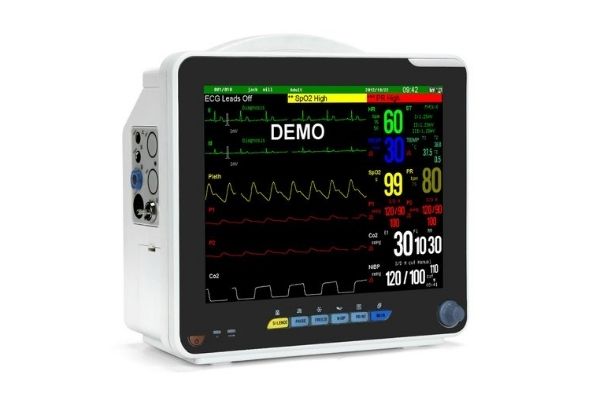Standard 6 parameters: ECG, respiration, non-invasive blood pressure, blood oxygen saturation, pulse, body temperature. Others: invasive blood pressure, end-respiratory carbon dioxide, respiratory mechanics, anesthetic gas, cardiac output (invasive and non-invasive), EEG bispectral index, etc.
1. ECG
The electrocardiogram is one of the most basic monitoring items of the monitoring instrument. The principle is that after the heart is electrically stimulated, the excitement generates an electrical signal, which is transmitted to the surface of the human body through various tissues, and the probe detects the changed potential, which is amplified and transmitted to the input terminal. This process is done through leads linked to the human body. The lead contains shielded wires, which can prevent electromagnetic fields from interfering with weak ECG signals.
2. Heart rate
Heart rate measurement is to determine the instantaneous heart rate and average heart rate based on the ECG waveform.
A healthy adult has an average heart rate of 75 beats per minute at rest, and the normal range is 60-100 beats per minute.
3. Breathing
Mainly monitor the patient’s breathing rate. When breathing calmly, 60-70 breaths/min for newborns and 12-18 breaths/min for adults.

4. Non-invasive blood pressure
Non-invasive blood pressure monitoring uses the Korotkoff sound detection method. The brachial artery is blocked with an inflatable cuff. A series of sounds of different tones will appear during the process of blocking the pressure drop. According to the tone and time, the systolic and diastolic blood pressure can be judged. During monitoring, a microphone is used as a sensor. When the cuff pressure is higher than the systolic pressure, the blood vessels are compressed, the blood under the cuff stops flowing, and the microphone has no signal. When the microphone detects the first Korotkoff sound, the pressure corresponding to the cuff is the systolic pressure. Then the microphone measures the Korotkoff sound from the attenuation stage to the silent stage, and the pressure corresponding to the cuff is the diastolic pressure.
5. Body temperature
Body temperature reflects the result of the body’s metabolism and is one of the conditions for the body to carry out normal functional activities. The temperature inside the body is called “core temperature”, which reflects the condition of the head or torso.
6. Pulse
The pulse is a signal that changes periodically with the beating of the heart, and the arterial blood vessel volume also changes periodically. The signal change period of the photoelectric transducer is the pulse. The patient’s pulse is measured by a photoelectric probe clamped on the patient’s fingertip or auricle.
7. Blood Gas
Mainly refers to oxygen partial pressure (PO2), carbon dioxide partial pressure (PCO2) and blood oxygen saturation (SpO2).
PO2 is a measure of the oxygen content in arteries. PCO2 is a measure of the carbon dioxide content in the veins. SpO2 is the ratio of oxygen content to oxygen capacity. The monitoring of blood oxygen saturation is also measured by photoelectric method, and the sensor and pulse measurement are the same. The normal range is 95% to 99%.
Post time: Nov-24-2021

